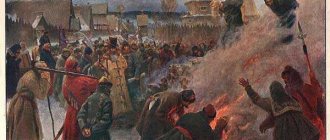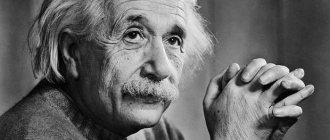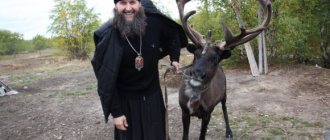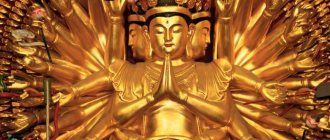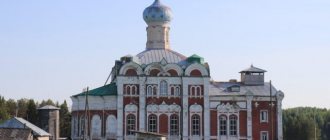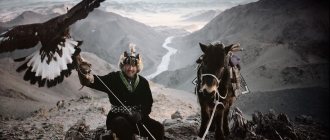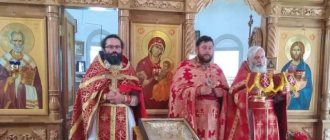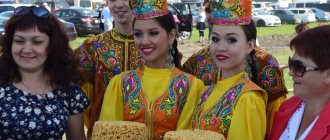Man appeared in Western Siberia in the 6th - 5th millennia before the birth of Christ. This is evidenced by the found tools: spear tips with flint and bone inserts. The Ob belonged to the Khanty. In the 19th century, the Mansi came here. They used to live on Northern Sosva. The Mansi and Khanty have a common religion.
Orthodoxy came to this region in the 18th century, during the reign of Peter I. The Khanty-Mansi diocese itself was formed in May 2011. There are more than 150 temples and churches in Khanty-Mansi Autonomous Okrug.
History and culture of the inhabitants of the Khanty-Mansi Autonomous Okrug
Mansi and Khanty have the same name - Ob Ugrians. These are related peoples, with almost the same culture.
It is believed that they have in common:
- origin;
- appearance;
- story;
- mixed marriages.
The Ob Ugrians live in the north of Western Siberia.
In the areas:
- Tomsk;
- Sverdlovsk;
- Tyumen.
Khanty
Khanty settlements are located near forests. This is an indigenous Siberian nation. The population is 31 thousand. Their winter clothes are more luxurious than those of the Mansi. They speak Khanty and Russian.
They trade:
- hunting;
- fishing;
- reindeer husbandry.
Muncie
Mansi live in the tundra. They are nomads. As of 2021, the population is 12 thousand. They speak Mansi and Russian.
Their activities:
- fishing;
- reindeer husbandry;
- agriculture;
- hunting.
Ancient beliefs of peoples
These two peoples believe in pagan deities. With the advent and adoption of Christianity, the Khanty and Mansi moved the statues of idols to the forests.
They bow to:
- trees;
- spirits of nature;
- animal totems;
- deceased forefathers.
Sacrifices to icons
Guided by their own customs, the Ob Ugrians smear blood on the lips of the saints.
Every family has an Orthodox icon. Their faces are compared to pagan gods. When a person needs help in any matter, he asks St. Nicholas the Wonderworker for it. For the Khanty and Mansi, he personifies the supreme deity - Num-Torum. Kaltas-ekva - Mother of God, she is also the goddess of the earth. Christian priests were unable to overcome such a mixture of religions.
Bear holiday
The Ob Ugrians believe that they descended from bears. This animal is a totem for them. But killing him is considered ok. When the bear is caught, all the residents celebrate.
Ritual with an animal:
- if a female bear is caught, they celebrate for 4 days, if it is a male - 5 days;
- they butcher the animal - skin it in front of the whole village;
- the front paws are not touched - the severed head is placed between them;
- a muzzle made of a white layer of birch bark is put on the male, and silver coins are hung over his eyes;
- The female's head is decorated with a scarf, and her neck is wrapped with beads.
You can see a bear skin in any house. The hunt for this animal is ongoing.
During the holiday:
- eat bear meat and traditional cuisine;
- they sing ritual songs;
- organize performances in a fun way;
- dancing.
The actors are only men, playing female roles too. By all rituals they remove the guilt for killing an animal.
Tradition of blood feud
Among these peoples, it is considered normal for entire dynasties to fight each other. When a relative is killed, the perpetrator's entire family pays.
The tradition also extends to bears. When an animal kills its hunter, a relative of the deceased is obliged to take revenge. It is customary to burn the obtained body of a clubfoot killer.
In this case, the following are not accepted:
- festivities;
- rituals;
- eating it.
Killing such a beast is an honor.
Honoring the spirits of nature
Worship of the elements of nature is the most ancient belief of these peoples. All nature is alive. When a tree needs to be cut down, they ask for forgiveness.
Signs of the vital force of nature include:
- breath;
- movement;
- height.
For example, a dead tree is considered dead. Snow flying from the sky is alive, but snow falling to the ground is dead. The power of life settles in stones, the shape of which is similar to a person or animal.
These peoples have ritual communication with spirits. The shaman helps to talk with them. The Khanty and Mansi worship forest and water spirits.
Air burial
Air burial is an ancient religious tradition. It was practiced until the 20th century. Only men were buried this way; women were buried in the earth. The body of the deceased was hung on a special cornice or laid on a makeshift hill.
This was done to give the body:
- air;
- spirit;
- light;
- tree.
With the help of the ritual, the soul flies away for rebirth and further incarnation on earth.
The dead were buried in the same way:
- Indians in North America;
- Georgians;
- Abkhaz-Adygs;
- Japanese.
Modern religions of the inhabitants of Khanty-Mansi Autonomous Okrug
There are many Christians in the Autonomous Okrug. It is believed that wearing a cross is fashionable. There are also Baptist and Catholic churches.
Orthodoxy
Christianity came here in the 18th century, when Russia was ruled by Peter I. Four thousand people were baptized in 1712-1714. All the revered idols found were destroyed.
Metropolis
The Christian Metropolis of Khanty-Mansiysk consists of several regions.
The Khanty-Mansi diocese was created on May 30, 2011.
For 2021, it includes:
- churches: parish - 61, ascribed - 15;
- prayer rooms - 33, houses - 20;
- chapels - 26.
The Ugra diocese was founded in 2014 on December 25.
It includes the following deaneries:
- Nyaganskoe;
- Yugorskoe;
- Beloyarskoe;
- Berezovskaya;
- Urayskoe;
- Kondiiskoe.
In the diocese of the Autonomous Okrug there are five gymnasiums and three Sunday schools.
Orthodoxy in the Khanty-Mansi Autonomous Okrug[edit]
The historical place of the birth of the Orthodox faith in the Lower Ob region can safely be called the town of Koda, now known as an urban village, the regional center of Oktyabrskoye of the Khanty-Mansiysk Autonomous Okrug of the Tyumen Region.
Ugra was famous for its wealth. In the 11th-12th centuries, Veliky Novgorod tried to impose tribute on the Yugrichi, taking from them “silver and sables and other ornaments.” Soon the Vladimir-Suzdal princes, and then the Muscovites, competed with the Novgorod governors in tribute-fighting.
The Yugrichi also had gold. The Russians went to Ugra for the purpose of profit. Obviously, quite often the warriors were accompanied by clergy, trying to instill faith in the hearts of foreigners. That's why they died. So, in 1193, the governor of Yadri, priest Legenoy and twelve “best people” were lured by the Ostyaks into their city besieged by the Novgorodians and “cut them all off.” In 1383, the Rostov monk Stefan Khrap became the first bishop of the Perm diocese with its center in the town of Ust-Vym, built on the site of a pagan temple. Historians believe that in retaliation for this, the Polym Vogulichs attacked Great Perm in 1455 and killed the Perm Bishop Pitirim. Again, in retaliation, the Grand Duke of Moscow and All Rus' John III ordered the Ustyug prince Vasily Skryaba to “fight the Ugra land,” which he did in 1465. The war “in revenge” continued for decades with varying success.
The year 1484 in our history is notable for the fact that for the first time in the relations between Russians and Yugrichi, the Perm Bishop Philotheus acted as a peacemaker. At his request, John III gave an “opas” (safe-conduct) to the Pelym prince Yumshan. Philotheus “sorrowed” before the Grand Duke for other captives and was one of the main witnesses at the conclusion of a peace treaty between the Russians and the Yugrichs.
At the end of the 16th century, Ermak became the “sovereign” of Siberia and, in particular, the Yugra land. The Stroganovs, and later Tsar John IV, did not set him the task of introducing Orthodoxy to Siberia, especially to the Ugra land. Enrichment through the enslavement of the Yugrichi was their main goal. Ermak's atamans repeated the actions of Stefan Khrapa. In 1585, trying to recapture the Big Ob city (perhaps it was next to Samarovo - the future Khanty-Mansiysk), the Ostyaks resorted to the help of their supreme deity.
Having besieged the city, they hoisted “Shaitan” onto a tree and “began to eat in front of him, as if with his help he would take Christians and put them to death.” But with a well-aimed cannon shot, the “shaitan” was defeated, and the frightened Ostyaks fled. Then they came with tribute and gifts to the winners, and took upon themselves the obligation to pay yasak.
The “Big” Prince Kodsky (Kondinsky) Alach (Alacha) himself came to the Cossack ataman Bogdan Bryazga, when most of the Ugra land was conquered, and concluded a friendly alliance. In response, Bryazg “install the prince of the great Alachey, for the land is rich,” from the mouth of the Irtysh to the mouth of Kazym. That is, instead of himself he appointed ruler over the entire territory that we now call the Lower Ob region.
According to legend, the supreme deity was in the Belogorsk principality, the capital of which - the Big Ob City - was captured by the Cossacks, and the idol was smashed from a cannon. Probably, there was more than one copy of the idol, or perhaps the shamans made another, but there is an assumption that the “shaitan” was transported to Koda. Deities from other Ostyak pagan tribes also came here.
To ensure their safety, Prince Alach went to Moscow in the early 90s of the 16th century and converted to the Orthodox faith. And in 1599, the widow of Prince Alach, also in Moscow, became the newly baptized Anastasia. At her request, in 1600, a church was built in Koda in the name of the Life-Giving Trinity with a chapel in the name of St. Nicholas of Myra. The princess was obviously guided by the fact that she sought to strengthen the power of her son Igich, who became the “big” prince after the death of his father Alach. For the same reason, in 1602, Prince Igich went to Moscow and accepted the Orthodox faith, building another temple in Koda - in honor of the Solovetsky miracle workers Zosima and Savvaty.
The year 1600 should be considered the year of the birth of Orthodoxy on the Ugra land among the Ostyaks (Khanty). First of all, the so-called noble class aspired to Christianity. In the first years of the 17th century, those who were baptized in Koda, in addition to Princess Anastasia and her son Igich, were the wife of the “big” prince Anna Purteeva, their children - converts Gregory, Mikhail and Ivan... The number of parishioners in the churches was so small that in 1608 the first When priest Evstratiy hit the king with his forehead, he said that “he has no business being here.” And that same year the churches were closed.
However, Alach’s grandson and Igich’s son, Mikhail, having become a “big” prince, restored the Holy Trinity and Zossimo-Savvatievskaya churches. He spares no expense in maintaining the temples. And they had everything necessary: “local icons, and those icons have applied shrouds and deesis, and holidays, and prophets, and forefathers, and cherubim, and seraphim, and every church building, the altar treasury, service vessels, silver, and the Gospel , altar crosses and blessings under the frame, with pearls and stones, and vestments.”
Images, bells and books sent to Koda in 1600 from Moscow were returned from Berezov. In addition, the princely arsenal was kept here, including 40 pieces of armor, bows and arrows... Prince Mikhail himself even donated silver vessels to the church. Therefore, we must assume that he sacredly preserved the legacy of his grandfather, Prince Alach, to whom one of the Tatar princes allegedly gave Ermak’s armor.
His heir, Prince Dmitry, did not take after his father. The subjects complained to the tsar that the prince himself, his mother and their people “newly baptized do not live firmly in the Orthodox Christian faith, they make prayers to the damned shaitans and in their nasty demonic treasury they give the shaitan a gift of clothes and horses, and the people give him from the arquebuses in the churches they are shooting at the crosses.” Moreover, Prince Dmitry allegedly gave his “wife” to the shaman for sacrifice.
Dmitry Alachev and his family were ordered to go to Moscow. “Having robbed the churches of God... the church building, silver vessels and books, he “taught to sell” them on the road. So he, Prince Dmitry, sold the “Lenten Triodion” while traveling from his estate, from Koda, on the Samarovskaya road to the coachmen.” Tobolsk Archbishop Gerasim stopped the trade. He ordered Dmitry to “bring the church property being sold to him to look at it as if it were for purchase.” And he confiscated silver vessels and printed books from the unlucky merchant: a set of 12 official Menaea and two Octoechos. The bishop reported what had happened to Moscow, and from there they ordered that everything taken be returned to the Trinity Church.
It must be said that Prince Dmitry was charged with the fact that, in addition to blasphemy, theft and speculation in church property, he also abused his official position and brought the Ostyaks to the point that they turned to the tsar with a request to free them from the power of the Alachevs and accept under the “sovereign hand”...
The new Tobolsk Archbishop Simeon took up the development of Orthodoxy in Ugra. In 1653, based on the petitions of the Ostyaks of fourteen Koda volosts, he informed the tsar: “In past years, in the Koda town, churches of God stood for many years, and Divine singing was performed throughout the years, and their brethren, many Ostyaks, heard the Orthodox Christian faith , coming to Kodsky town, they were baptized; and now that Kodsky town has become empty, and the churches of God stand without singing.” Vladyka Simeon asked the Tsar: “to welcome them, to order a monastery and elders to be baptized in the place where the churches of God stand.” And Alexey Mikhailovich signed a letter on October 20, 1653, in which he ordered: “In that Kodsky town, the monastery and the elders, the sexton and the sexton should be both a servant and a salary for them.”
Kodsky Monastery. A group of nuns and their students.
This is how the Kodsky monastery appeared. Over time, the temple grew stronger and stronger, but the church in the name of Saints Zosima and Savvatius was practically not used from the very beginning and was completely closed. But next to the Trinity Church “in a new fence” a “new, warm, tented church was built, with a refectory and a cellar with an altar, an altar and an altar. And in the name of that Church of the Annunciation of the Blessed Virgin Mary.”
The territorial possessions of the Koda Principality expanded, which means that the zone of influence of the Koda Monastery increased geographically. The principality spread territorially not only from Samarovo to Berezovo along the Ob River, but had fertile lands on the Iset, a settlement near Yalutorovsk, its own farmstead in Tobolsk and Samarov... The number of believers was so large that churches were built in towns along the Ob.
The second revival gave Orthodoxy flourishing and scope. In the 50s of the 18th century, a stone building of the Holy Trinity Church appeared in Koda, which was the tallest building up to Tobolsk. The bells here were cast from their own copper, deposits of which “Ivanishche” Kodsky (chroniclers call him either a housekeeper, a builder, or a miner) discovered right under the monastery. In order not to disturb the peace of the monastery, he hid this fact not only from Moscow, but also from Tobolsk. Copper ore was mined secretly (this explains the existence of two underground passages with a total length of one and a half dozen kilometers), “Ivanishche” transported it to Moscow, melted and cast bells.
By the 90s, again, for the third time, the question of closing the Kodsky monastery arose. But they decided to transfer the neglected cases into women’s hands. In 1891, it was transformed into the Holy Trinity Monastery for women, with subordination to the St. John the Vvedensky Convent of the Tobolsk-Tyumen Diocese.
But the twentieth century came, in which the Tobolsk-Tyumen diocese gave the world dozens of holy new martyrs...
On May 30, 2011, by the decision of the Holy Synod, the Khanty-Mansi diocese was formed within the Khanty-Mansi Autonomous Okrug. This happened by separating it from the Tobolsk-Tyumen diocese. The Synod decided that the ruling bishop of the Khanty-Mansi diocese should have the title of Khanty-Mansi and Surgut. By the decision of the Holy Synod of December 25, 2014 (journal No. 120), the Yugra diocese was separated from the diocese. The Khanty-Mansi diocese is included in the Khanty-Mansi Metropolis.
Temples to visit
The confessor, priest of the Khanty-Mansiysk and Surgut diocese, Pavel, conducts Divine Liturgies in different churches in the cities. You can view its schedule on the official website - Ugra Orthodox or in the VK group.
The dioceses of Khanty-Mansi Autonomous Okrug number 156 churches, temples and houses of worship.
Resurrection Cathedral
The Church of the Resurrection of Christ in Khanty-Mansiysk was erected on June 25, 2005. This is a cathedral dedicated to the resurrection of Christ.
The complex consists of:
- Orthodox park;
- Sunday school;
- gymnasium.
There are fountains in the park that are turned on in the summer.
Temple in honor of the Icon of the Mother of God “The Sign”
The Znamenskaya Church in Khanty-Mansiysk is made of wood. Its construction lasted four years: from 1991-1995. You can attend religious services every day.
It contains:
- video library and library;
- Sunday School;
- kindergarten.
Intercession Cathedral
The construction date of the Church of the Intercession of the Blessed Virgin Mary in Khanty-Mansiysk is unknown. There is a mention that Metropolitan Fedor of Tobolsk built Christian churches on pagan temples in 1712.
The temple has three altars:
- main;
- southern;
- northern.
Every Sunday you can attend the Divine Liturgy. It is held at 8 am.
Traditional shamanism
Each settlement had its own shaman. The villagers communicated with spirits and gods through him.
The duties of the sorcerer included:
- predicting the future;
- healing;
- maintaining communication between the living and the dead.
Also, in case of trouble, the shaman was supposed to console the person.
They could do without it in ceremonies:
- birth of a child;
- marriages;
- burials.
These rites were performed by clergy or elders.
The sorcerer was always invited:
- for difficult childbirth - as a healer;
- for marriage - as a guardian;
- at a funeral - in the role of an experienced escort.
During sacrifices, the shaman indicated which animal should be slaughtered. Usually deer or horses were sacrificed. The sorcerer himself did not kill anyone, he accompanied the soul of the beast and prayed. The ritual was performed to get rid of troubles or illnesses.
Mythology
The myths of these peoples express idolatry.
A few legends:
- The myth about the appearance of the Earth says that water is the basis of all living things. The ground was deep under water, but a piece of peat floated on top. There was a house on it where a wife and husband lived. They had a waterfowl - the ghagra. With her beak she took out small pieces of earth from the water and attached them to the island.
- Their grandson, the white raven, tells his wife and husband about the shape, growth and rotation of the Earth. When the earth became very large, the raven did not fly for a long time - it was on reconnaissance. The raven got hungry and saw the corpse of a man. He ate three pieces and turned black. His grandparents were upset by his behavior, and he remained that way forever.
Content
- 1 Orthodoxy in the Khanty-Mansi Autonomous Okrug
- 2 Settlements
- 3 Saints
- 4 Shrines
- 5 Orthodox monasteries 5.1 Monastery of Demetrius of Rostov (Khanty-Mansiysk)
- 6.1 Church of the Transfiguration of the Lord (Surgut)
Worshiped Deities
The mythological worldview of these peoples is divided into three tiers. Each of them is represented by its own deity.
Upper world
The supreme god, Num-Torum, belongs to the heavenly or upper world. It creates daylight and preserves morality and order in human souls. Various tales have been written about him. He is depicted as an old man in clothes embroidered with gold, in a house full of treasures. He monitors the human world through an opening in his luxurious home.
Middle world
This is the world of people. Many gods and spirits live in it. Basically, these are relatives of Num Torum.
Main gods:
- Nai-imi - goddess who rules fire;
- Tylash-imi - month;
- Muv-Anki - mother earth;
- Yan-shut-iki is the lord of water.
Netherworld
The lower or underground world is ruled by Kul, the brother of Num-Torum, who is also an evil spirit.
Another name for this world is ely-ma. This is the abode of the dead. There is never any sun here. But there is a month, but it never becomes the full moon.
Every week Kul receives a list from Num Torum indicating who should die. It happens that the ruler of the underworld takes a soul by mistake, but is obliged to return it. This is how people explain prolonged fainting.
Saints[edit]
- Saint Nektarios, Archbishop of Tobolsk and Siberia
On April 1, 2015, under the chairmanship of Archpriest Nikolai Matviychuk, a meeting of the commission for the canonization of saints was held in Khanty-Mansiysk. The Commission for the Canonization of Saints was created in accordance with the decision of the Administrator of the Diocese in accordance with the definition of the Holy Synod of October 6, 2011 on the approval of “Recommendations for the activities of diocesan commissions for the canonization of saints” as mandatory for use in the dioceses of the Russian Orthodox Church. And also in accordance with the decision of the Consecrated Council of Bishops, held in Moscow from March 31 to April 4, 1992, which says: “To form in all dioceses of the Russian Orthodox Church commissions for the canonization of saints to collect and study materials for the canonization of ascetics of faith and piety, especially martyrs and confessors of the 20th century, within each diocese"
Holidays and rituals of the Khanty and Mansi
These peoples value and respect the land. They are prohibited from injuring her with any object. Ugrians were not allowed to walk along the banks of certain lakes and rivers. When the Khanty and Mansi pass by holy places, a ritual of sacrifice is performed. They give away their food or tear a piece of cloth from their clothing and leave it there.
Raven Day
The holiday is celebrated on April 7 - the day of the Annunciation. It is believed that crows bring warmth and awaken nature with their cawing. This bird patronizes children and women.
It is believed that this bird rejoices at the birth of children.
On Raven Day:
- cook food over a fire;
- they place a table with delicacies near a birch tree;
- They tie white coins in scarves and ribbons, bringing them as a gift to the spirits.
Leftover food is thrown aside to feed imaginary crows.
They do this so that the bird gives:
- success;
- warm weather;
- well-being.
At a festival in honor of crows, boys choose their brides.
Day of the Hunter, Fisherman and Reindeer Herder
The celebration is held at the end of March. That's when the fishing and hunting season ends.
On the holiday the following will be organized:
- sports tournaments;
- reindeer and snowmobile racing;
- jumping over a sled.
The winners receive prizes.
